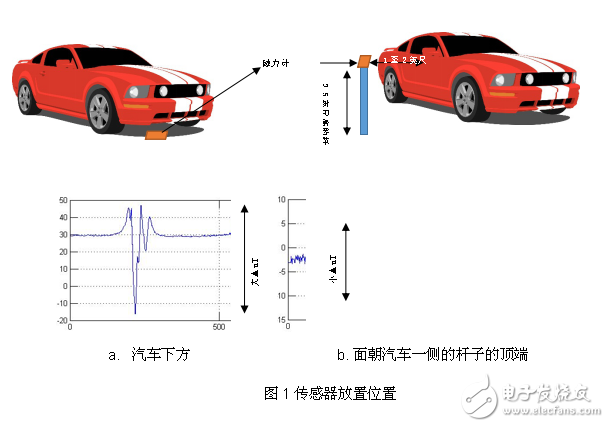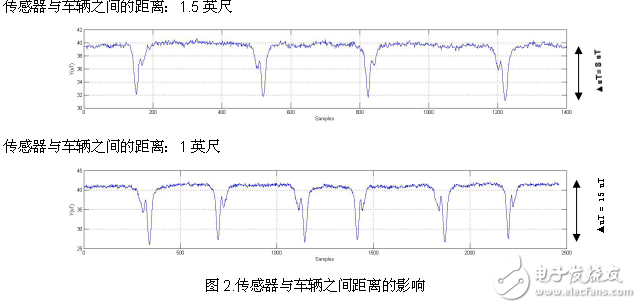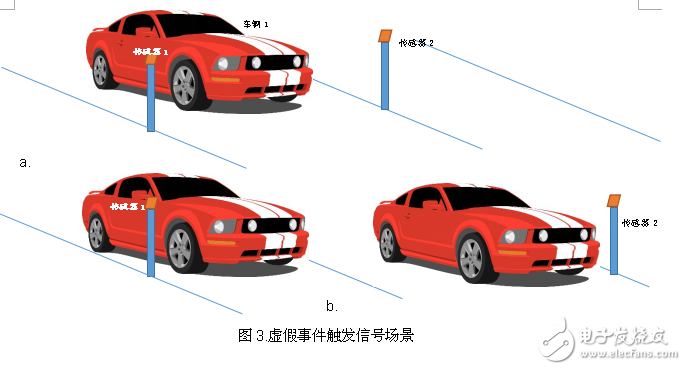In the previous blog post, we explored the basic concept of using a magnetometer for vehicle detection. This week, we will explore in detail the ideal sensor placement and some of the challenges in vehicle detection accuracy. Sensor placement The measured flux density or field strength will decrease as the distance between the sensor and the vehicle increases. This can cause the signal to become very weak and difficult to detect and analyze. Therefore, the effective placement of the sensor relative to the surface of the car is an important consideration. Mounting the sensor on the road (near the surface) is the most common and effective method, as shown in Figure 1. Since the bottom of the car is where the metal is most concentrated, this method is used to detect the presence of the vehicle. Another ideal location is a 2.5-foot-tall pole top mounted on the side of the lane with an optimal distance of 1 to 2 feet between the pole and the moving vehicle. From the corresponding characteristic waveform diagram, we can see that when the sensor is placed on the road surface, the change of the magnetic field strength in the signal waveform diagram is more intense. Figure 2 shows how increasing the distance between the sensor and the car affects the strength of the signal being measured. Vehicle detection problem All right! Now that we understand the basic concepts related to car sensing, let us now use a simple threshold-based detection method to detect the presence of a vehicle. For example, if the RMS value of the signal under test (all X, Y, and Z axes) is above a user-defined threshold, the vehicle is determined to be present/passed, and vice versa. While this approach may seem simple, in some important scenarios it may generate false positive/negative triggers. Considering the size of the vehicle (from bicycle to truck), the amount of black metal in contact with the earth's magnetic field is also different, so the measured signal strength changes will also vary. This means that adopting a universal activation threshold is not an excellent solution for detecting all vehicle types. In addition, the sensor's signal baseline (ie, under a zero-flux magnetic field) can also make small differences due to temperature. This change in offset due to temperature changes can cause false triggering signals. Therefore, instead of just using threshold-based detection methods, we can use pattern recognition techniques to understand related features. This helps to obtain meaningful time or frequency domain characteristics such as mean, standard deviation, correlation between axes, minimum/maximum values, and more. Initially, training models can be built by acquiring the characteristics of various types of vehicles (by size). The utility of the pattern recognition training model will be determined by the size of the training set. Therefore, the pattern recognition model can help us effectively identify the presence of the vehicle by carefully analyzing the features without considering the operating conditions. Another common and obvious challenge is how to prevent false triggering problems in the scene shown in Figure 3a. Can sensor 2 be aware of the presence of vehicle 1? How do we explain this and prevent false triggers from adjacent lanes? We can place the sensor at the end of the road as shown in Figure 3b, but it is very tricky for multiple lanes. Therefore, a quick method is to use the magnetic shield sensor (in this case, the sensor 2) to the rear, which can reduce the magnitude of the field strength caused by the vehicle 1 to the sensor 2. That is, if the magnitude of the signal change measured by the sensor 1 (when the vehicle passes) is greater than the signal change measured by the sensor 2, it means that the car is actually in lane 1, not lane 2. In addition to using a magnetometer for simple vehicle testing, we will introduce some potential use cases and applications in the next series of blog posts. In the meantime, please visit our website to learn more about magnetometer products. Disposable Oil Vaporizer,Ceramic Oil Vaporizer,Cbd Juice Vaporizer,Disposable Cbd Juice Oil Vaporizer ALD GROUP LIMITED , https://www.aldvapor.com

